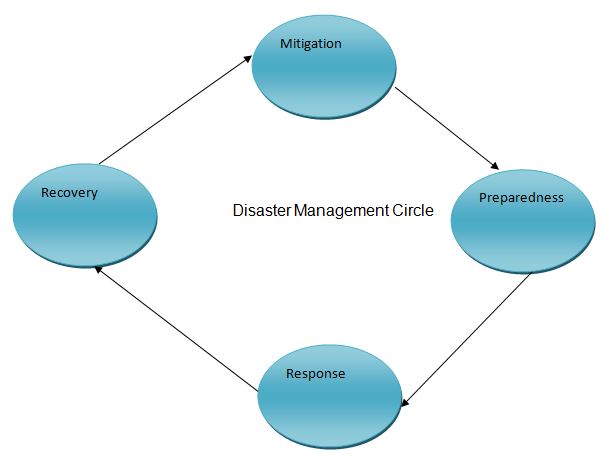Introduction
In many organizations, it is always difficult to avoid some risks because of the nature of the business or some other natural forces that are beyond human control. According to Veenema (2013), an organization cannot evade some risks, and for this reason, the best approach would be to develop measures that can help mitigate these risks.
When analyzing the fundamentals of risk management, it is necessary to understand some of the stages involved when managing risks, and how they are related. This research paper will focus on the analysis of the relationships between mitigation, preparedness, response and the recovery phase of the disaster management cycle.
Discussion
Disaster mitigation, preparedness, response and recovery are the four stages of disaster management circle. These four stages are closely related in that one stage leads to the other one. According to Bhattacharya (2012), the four stages of disaster mitigation circle are closely intertwined in a manner that any failure in the first stage would lead to the failure in all the remaining four stages.
The first stage of disaster mitigation would necessitate disaster preparedness which leads to disaster response, and finally ends at the recovery stage. This means that if an organization fails to develop proper mitigation measures, then the other three stages will be a failure. Consequently, all of the stages are closely interrelated and, therefore, must be looked as part of an integrated system. It would be necessary to define and analyze what takes place at each of the stages.
Mitigation is the first stage in the disaster management circle. Coppola (2011) states that mitigation is the direct effort to minimize the effects of a disaster within an organization, a society or even a country. The scholar says that, in most of the cases, mitigation is taken based on a past case or incident that took place in another society, country, or an organization. At this stage, the emphasis is placed on the development of measures that will help protect the society or organization from the adverse effects of a disaster in case it takes place.
One common example of mitigation that many organizations prefer is taking an insurance cover against the anticipated disaster. This way, the organization knows that in case a disaster occurs, some of the costs will be met by the insurance company. That is one of the best ways of minimizing its impact. Another example that is common when addressing issues that affect the society is to organize public awareness campaign. This may involve educating the public about the disaster.
The second stage is disaster preparedness which involves the plans that are in readiness to face any disaster in case it takes place. Within an organization, installing fire extinguishers, fire alarms and emergency exits may be important when planning on how to minimize casualties in case of fire. In a society, the government may consider stocking extra food or water in readiness for a famine. It may also involve building of dikes in case a given area is prone to flooding.
The third stage is the disaster response, which is the actions that are taken during or immediately after a disaster has occurred. It would involve implementing the plans developed at the initial stages of this circle. In an organization, it would involve sounding the bell to warn people of the dangers of fire, using the extinguishers to manage fire, directing people to use the emergency exists, and rescuing those who are trapped. In a society, it may involve distributing the relief food.
The recovery stage is the last phase, where the authority and other concerned individuals will try to bring normalcy to the organization or the community. These are activities that are done to help the victims or to restore structures that were damaged during the disaster.
This may include offering medical care to those who were injured, providing temporary shelter in cases where homes were destroyed in the disaster, or giving grants to the affected organization to enable it get back to its feet after the disastrous event. These stages are summarized in the table below.

Conclusion
Risk management is a complex process that requires a clear plan that would help an organization or a community to minimize the impact of a disaster in case it occurs. Managing risks takes place in four stages as explained above. Each of the four stages must be properly executed in order to achieve the desired results.
References
Bhattacharya, T. (2012). Disaster science and management. New Delhi: Tata McGraw Hill Education.
Coppola, D. P. (2011). Introduction to International Disaster Management. Burlington: Elsevier Science.
Veenema, T. G. (2013). Disaster nursing and emergency preparedness for chemical, biological, and radiological terrorism and other hazards. New York: Springer Publishing Company.